You never know what you might see when you go for a walk. Today was a pretty slow day birdwise at Fern Forest; the only migratory warbler I saw was an Ovenbird, and s/he was in the favorite habitat of this species: the undergrowth. The light was too low to get a picture. But out in the middle of the prairie, where the light was absolutely beautiful, was, according to my Capinera guide to Grasshoppers of Florida, Shistocerca americana, an American Grasshopper:
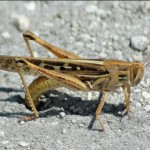
The only photos I have in the guide are of the male and of the nymphal stages, but I’m quite sure that this is a female–if that’s not ovipositing, I don’t know what is. (And really–I might not know ovipositing when I see it; I’m no entomologist!). According to my field guide, the American Grasshopper
is a large, strong flying species that is numerous enough, on occasion, to become a crop and tree pest. American grasshopper is normally brownish or yellowish brown, with lighter and darker areas. It usually bears a dorsal creamy white stripe extending along the front of the head to the tip of the forewings.
American grasshopper occurs throughout Florida and the eastern United States. It is unusual in having two generations annually, one usually in April-June and another beginning in August or September. The adults overwinter, and are active in the winter whenever it is warm and sunny.
I suppose with it being mid-September, this female was laying the eggs that will “overwinter” and hatch to become adults next Spring? Or are we far enough south that there is no seasonal variation? Questions that remain to be answered…
After I left the prairie, I went around the Cypress boardwalk, where I came across an example of interspecies competition: a strangler fig sending out roots from its perch high in the crotch of a gumbo-limbo (Bursera simaruba). This particular gumbo had been an amazing specimen, but it appears to have died in Hurricane Wilma; I have a few old photos documenting the decline and fall of this lovely tropical tree.
In the first image, we have the trunk of this giant tree before any of the problems became visible. If you look really close, you can see a small strangler fig growing in the main crotch.

Here you can see why the tree is failing: that is its own limb hanging down over the trail, caught in itself. The winds here in Florida are quite brutal. The gumbo limbo has chosen the breakdown strategy of dealing with hurricanes: the brittle limbs resprout quite readily, so even though the wind might break apart the parent tree, it will live on through the debris. Not quite phoenix-like, but close.
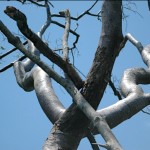
Below, you can see the damage to the tree caused by some type of bird. It’s a bird with a chisel for a beak, and strong tailfeathers to help it cling to vertical trunks while it drills into tree trunks searching for insects. Not sure what it’s called, but it pecks wood with its beak. Why don’t we call it a woodpecker?
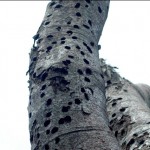
Here you can see one individual hole, and what the woodpecker might have been after (the tiny ant visible on the inner hole, at about the one o’clock position):
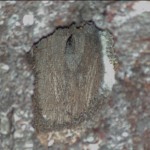
[UPDATE: the damage to this tree appears to have been caused by insects, not woodpeckers.]
So that was the history of this gumbo-limbo tree a couple of years after some mighty hurricanes hit the site. But today, the interest was what was growing, quite literally, in its place: the strangler fig, Ficus aurea. This tree has an interesting way of going about its business: it can start growing from up high in the tree, epiphytically, or it can grow up from near the bottom; it all depends on where its fruit, scarified by passage through a bird’s digestive system, lands. Wherever it ends up, if it germinates, it then send roots down to the floor, no matter how far away that floor might be.
In the photo below, you can see the strangler fig has really taken hold, just a few short months after the first photo was taken.
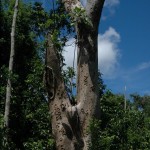
Here is a close-up of the aerial root of the fig as it grows down, searching for soil:
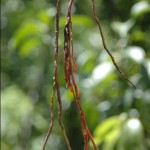
And here is a larger root node, shown against the backdrop of the now barkless gumbo limbo:
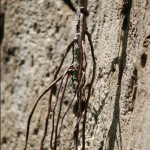
Normally, the strangler fig takes over a living tree, as you can see in this photo of the giant roots wrapping around a cypress tree:
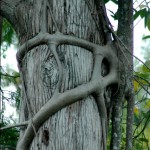
If the fig wins, the host tree dies and eventually rots away, leaving a hollow space inside the living fig which eventually gets grown in. If the host tree “wins” the fig and the host tree simply coexist until one or the other gives up the ghost.

